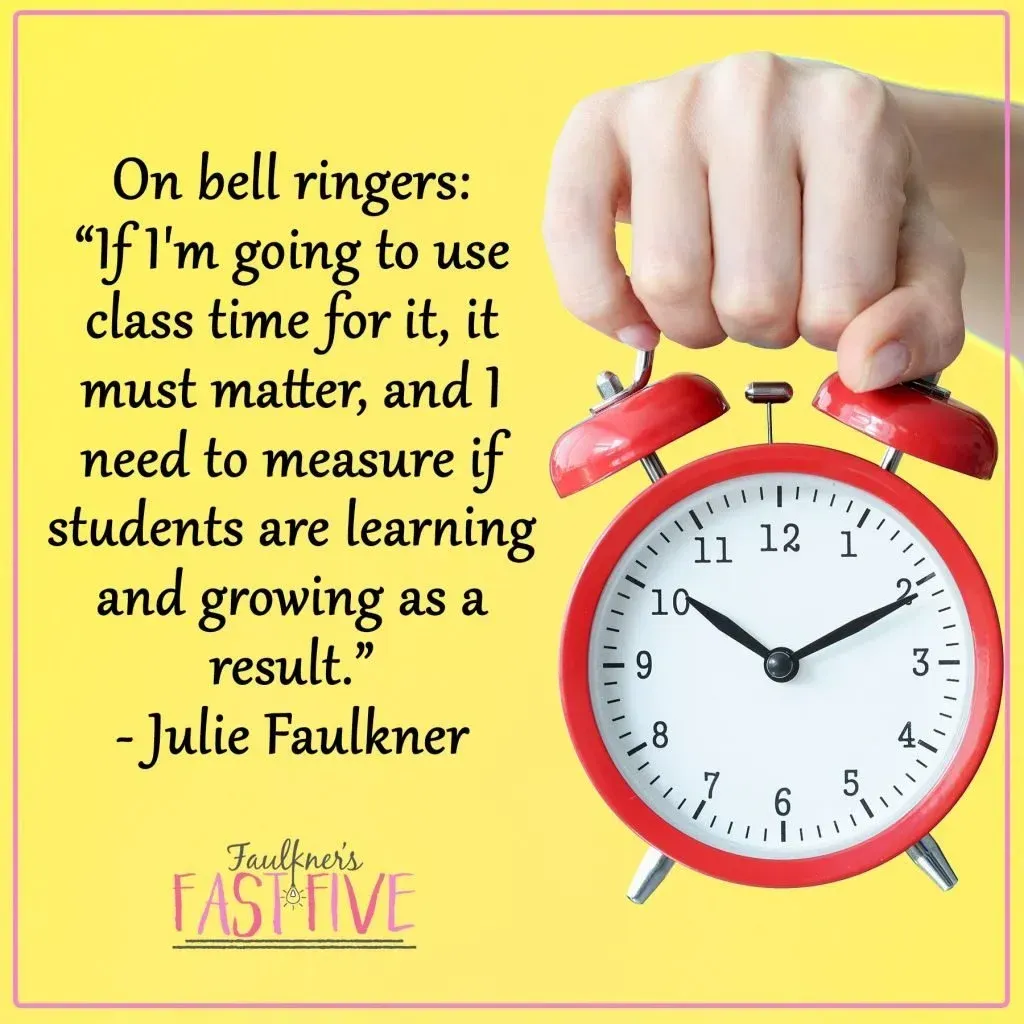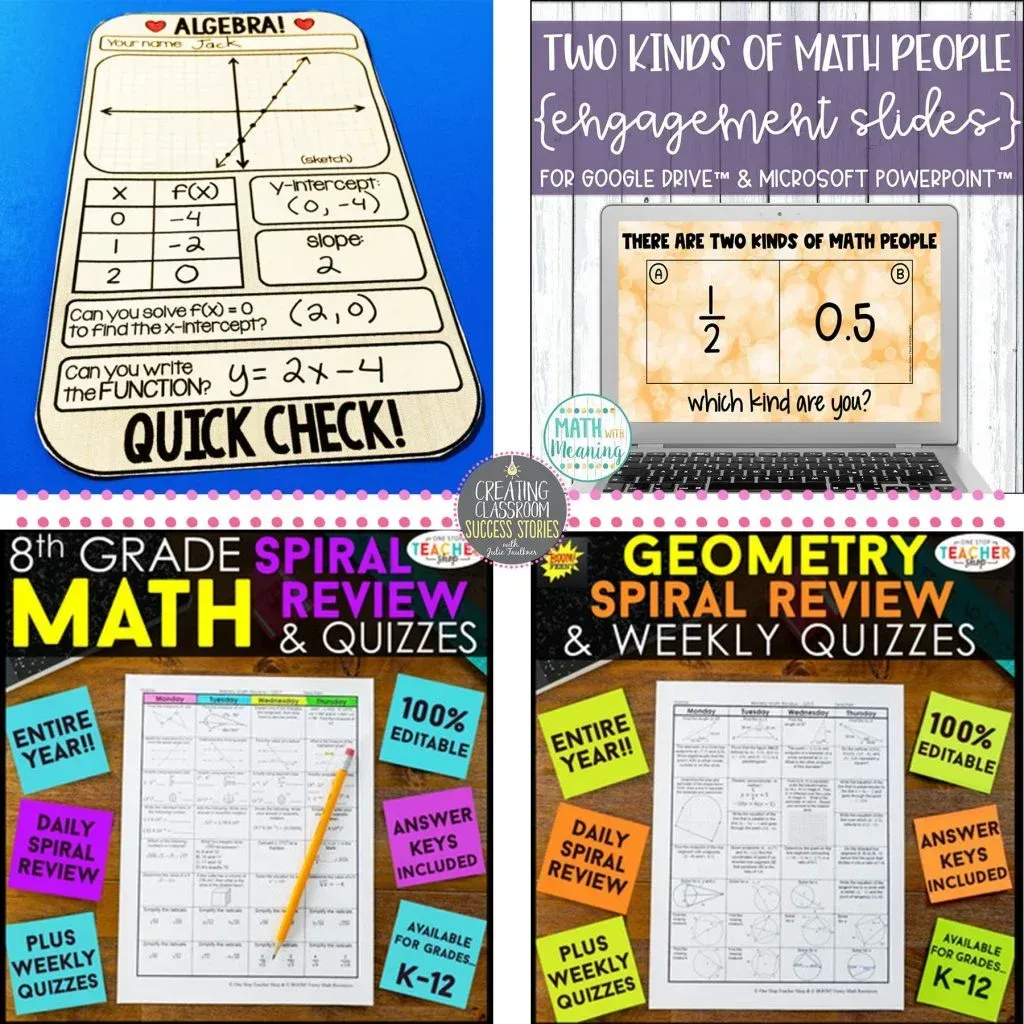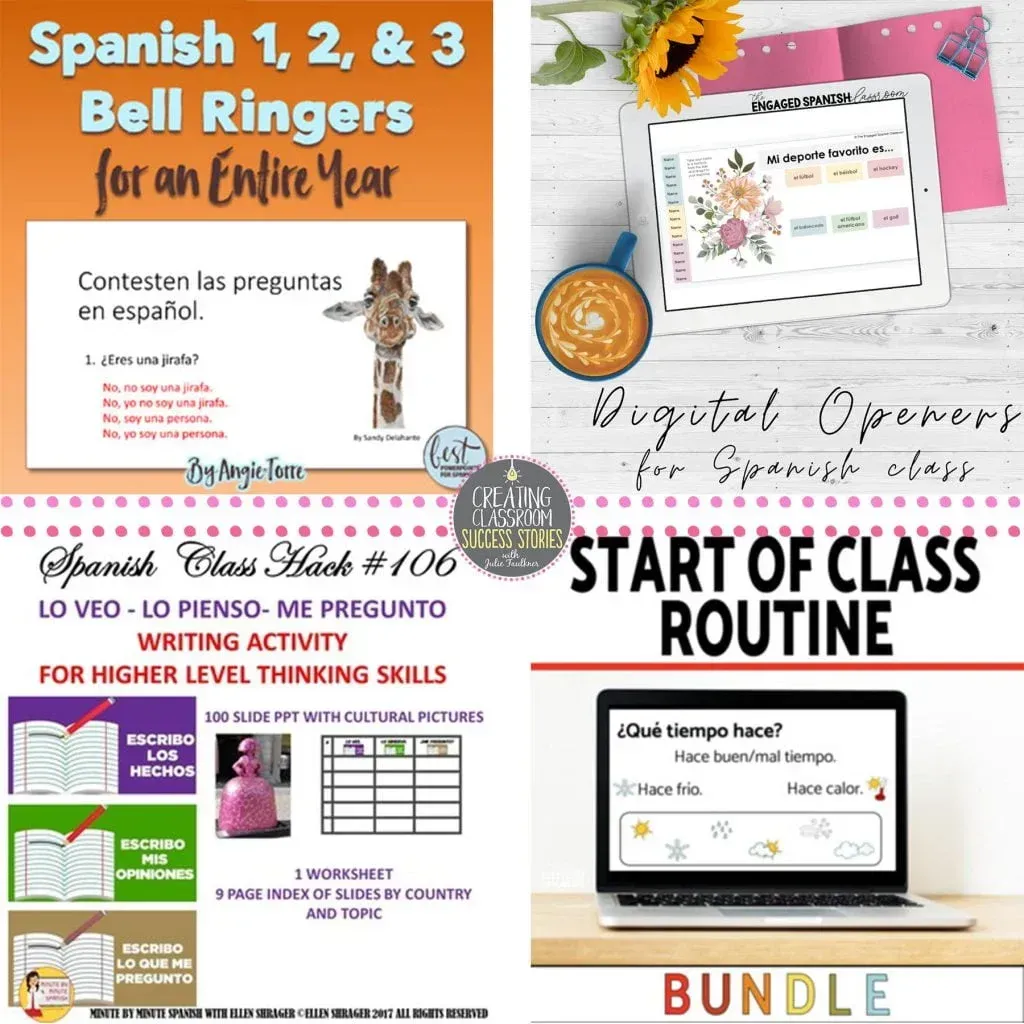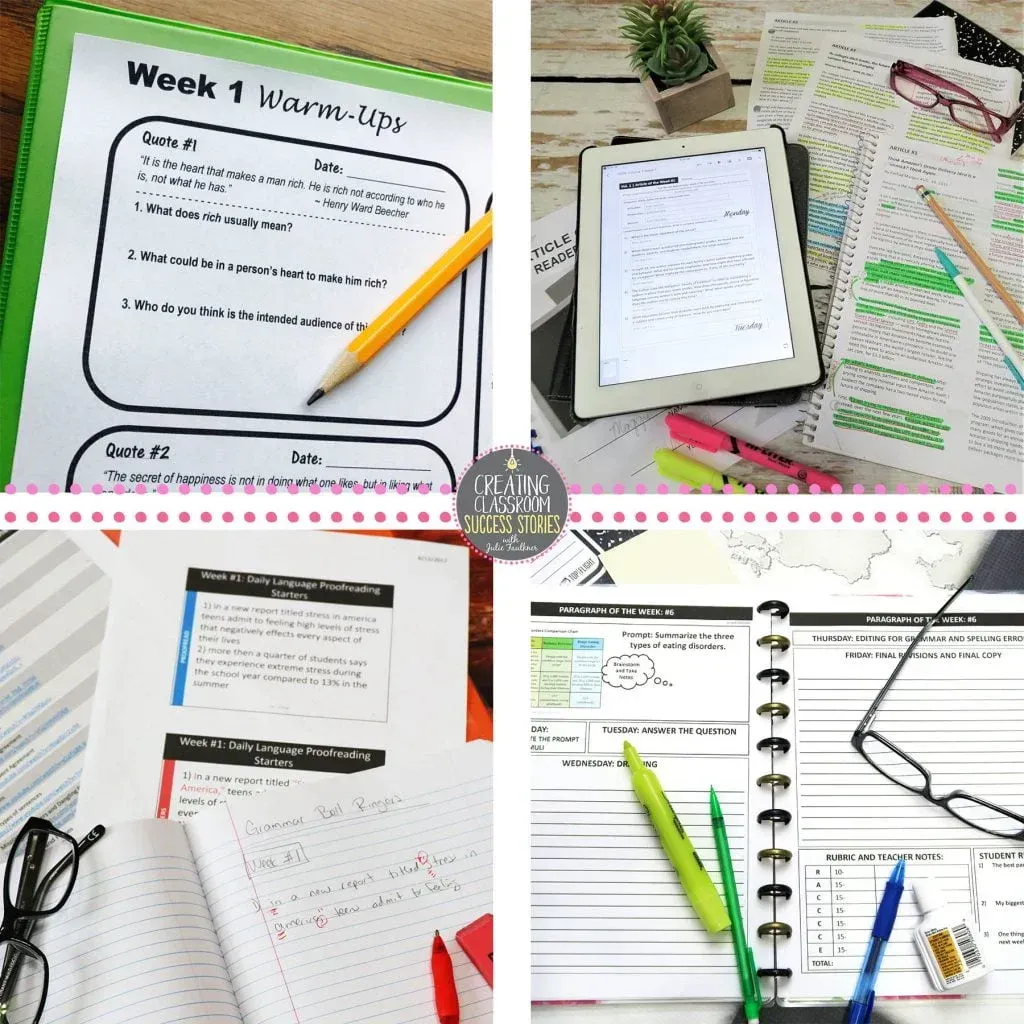Everything You Need to
Know About Bell Ringers
Bell ringers are a staple in my high school English classroom. Even my yearbook students must complete a task at the start of the period. Without fail, each day my students have an assignment to do right after the bell rings — every day! About my 2nd or 3rd year teaching, I implemented a system of top-of-the-period daily work, and I haven’t looked back since. Along the way, I learned what didn’t work and what did. Here I’m sharing everything you need to know about bell ringers for secondary, any subject!
WHAT IS A BELL RINGER?
Also known as warm ups, bell work, do-nows, openers, entry-tickets, or jump starters, a bell ringer is the short activity that students do upon entering the classroom. They may be standards-driven, spiral review-orientated, inspirational, challenging, or even game-like. Bell ringers are more than just “something students do while you check roll;” they are the engine to the classroom train, the secret sauce to setting the tone, and the trick to calming the chaos.
BENEFITS OF USING BELL RINGERS
There are many, many reasons why you should start each period with a bell ringer. Those advantages include establishing classroom management/procedures, engaging students, helping students mentally prepare as they’ve transitioned to a different subject, implementing skill drills, and squeezing in spiral review. Of all the perks on this list, the top two reasons why I love bell ringers so much are establishing classroom management/procedures and drilling skills. I use my Ten-Minute Grammar Program each day to set the stage when students come in, and this choice allows me to cover ALL those grammar skills. We do work from “bell to bell” in my classroom, but I can’t start teaching right away because of attendance, announcements, etc. However, because my bell ringer is ready-to-go when students enter, they are working immediately. That also lets them know that a certain level of responsibility and academics is expected in my class.
WHAT TO AVOID WHEN USING BELL RINGERS
While bell ringers are the “best thing since sliced bread” for a classroom, you do need to implement them correctly in order for them to work. Three major pitfalls I’ve seen with teachers using bell ringers ineffectively are being inconsistent, selecting irrelevant/meaningless/basic/disconnected material, and never holding students accountable. Bell ringers must be used daily; otherwise students forget that’s the routine, and they take longer than intended to get started, etc. Secondly, bell ringers must be important, meaningful, and useful for students; otherwise they know it’s just busy work. Avoid selecting tasks that do not connect to your class’s goals or even your students’ learning levels. I don’t have students write in journals each day or record their feelings about a famous quote because that’s not a standard I’m trying to cover. Choose something that requires thinking and action; just reading a fact, writing a definition, or copying down a definition doesn’t require much of students. These types of tasks could be strengthened by adding a follow-up question or other requirement that increases the level of critical thinking. The third huge “no-no” when using bell ringer is not holding students accountable. Students always ask “is this for a grade?” While that question does make my eye twitch, it is relevant. We don’t want to do work that isn’t going to “count,” either. So, there must be some level of accountability. I don’t think that a completion grade or notebook check always suffices, either, and that’s another reason why I feel the bell ringer tasks really need to be standards-based. If I’m going to use class time for it, it needs to matter, and I need to measure if students are learning and growing as a result.

WHAT TO AVOID WHEN USING BELL RINGERS
For example, when my students do their ten-minute grammar exercises each it day looks something like this: On Monday, Tuesday, and Thursday, they correct two sentences for errors. They do them on their own, and then we go over them and take notes (grammar rules) for the corrections on their paper. I do not collect those notes. Instead, I give a multiple choice grammar quiz on Friday where I test those skills we covered for the week. The catch? Students can use their daily notes! If they don’t take notes, they are at a disadvantage on Friday’s quiz. Does it work? You bet! EVERYBODY takes notes all week, and all I have to grade is a quick multiple choice quiz once a week. With my yearbook students, their bell ringers look a little different. They are completing different tasks daily in a notebook-style resource, but each task still relates specifically to honing their journalism/photography/grammar skills. Most days we go over their answers in class, and then I evaluate their responses more in depth at the end of the week. Ultimately, I see them producing better pictures, writing, and content in the publication of our book. The same is true for my grammar exercises — student writing and test scores improve drastically.
A few other things that can sidetrack your bell ringer game are failing to help students be organized and mistaking the bell ringer for the “set” to your lesson. Especially if you are working with younger students or students with IEPs, it would be very helpful to have students create a notebook or folder just for the bell ringer activities. Take it one step further and have a place in your room for them to store it. Lastly, I don’t consider the bell ringer as part of my core lesson. Having students “Tweet” something from yesterday’s lesson, recalling a fact on a sticky note, reflecting on their understanding of this week’s skill, etc., is really more of a lesson set or lesson activator than it is a bell ringer. For me, the bell ringer and lesson set activities are not related – apples and oranges. Even when I have only 45-minute periods, I still used a separate bell ringer each day.
TIPS FOR HOW-TO USE BELL RINGERS EFFECTIVELY
- Step 1: Evaluate which skills/goals you want to meet with your bell ringer time.
- Step 2: Design/Select tasks that students can attempt on their own and that can be done in a short amount of time.
- Step 3: Decide how you will evaluate student learning and/or hold them accountable for their work. Consider tasks that are easy to check daily or weekly. Instant feedback is always preferred.
- Step 4: Plan to have the bell ringer on the board while classes change, so it is ready when students enter.
- Step 5: Initially, model the procedure, proper responses, and expectations. Give students students several days to practice the procedure before letting them swim on their own.
- Step 6: After a few weeks, evaluate the procedure and results from a teacher standpoint. If you find something isn’t working, change it! You know your classroom and students best!
GET GOING THESE GREAT OPTIONS FOR BELL RINGERS IN ALL SECONDARY SUBJECTS
For English/ELA:
- Ten-Minute Grammar by Julie Faulkner and Read more about my Ten-Minute Grammar procedure here
- Paragraph of the Week (High School) by Julie Faulkner
- Paragraph of the Week (Middle School) by Julie Faulkner
- Article of the Week (High School) by Julie Faulkner
- ELA 7th Grade Spiral Sheets (Even though these are labeled as homework, they work perfectly for bell ringers.) by Julie Faulkner and One Stop Teacher Shop
- ELA 8th Grade Spiral Sheets (Even though these are labeled as homework, they work perfectly for bell ringers.) by Julie Faulkner and One Stop Teacher Shop
- ELA Bell Ringers Upper Elementary Middle School by Martina Cahill – The Hungry Teacher
- Digital Middle School ELA & Reading Bell Ringers by Delightful Designs- Alissa Cook
- Inspirational Quotes Daily ELA Bell Ringers by English Teacher Mommy
For Math:
- Linear Equations by Scaffolded Math and Science
- Spiral Math Pages 7th Grade (Even though these are labeled as homework, they work perfectly for bell ringers.) by One Stop Teacher Shop
- Spiral Math Pages 8th Grade (Even though these are labeled as homework, they work perfectly for bell ringers.) by One Stop Teacher Shop
- Geometry Bell Work Prompts for the Entire Year by One Stop Teacher Shop
- Algebra 1 Spiral Review by One Stop Teacher Shop
- Geometry Spiral Review by One Stop Teacher Shop
- Algebra 2 Spiral Review by One Stop Teacher Shop
- Two Kinds of Math People Engagement Slides by One Stop Teacher Shop
- Algebra 1 First Semester Warm-Ups / Bell Ringers by MathHop by Jackie B

For Spanish:
- Spanish Digital Openers and Exit Tickets
- Start of Spanish Class Check In Routine
- Spanish One Two and Three Bell Ringers for an Entire Year
- 106 Spanish Higher Level Thinking and Writing with Cultural Pictures

For Science:
- Reading Graphs Worksheets Print and Digital Bundle by Classroom 214
- Reading Graphs, Charts, and Diagrams Data Analysis Middle School Boom Cards by Classroom 214
For Yearbook/ Journalism:
Other:
Love this content?
Sign up for my email newsletter with more tips, ideas, success stories, and freebies!















